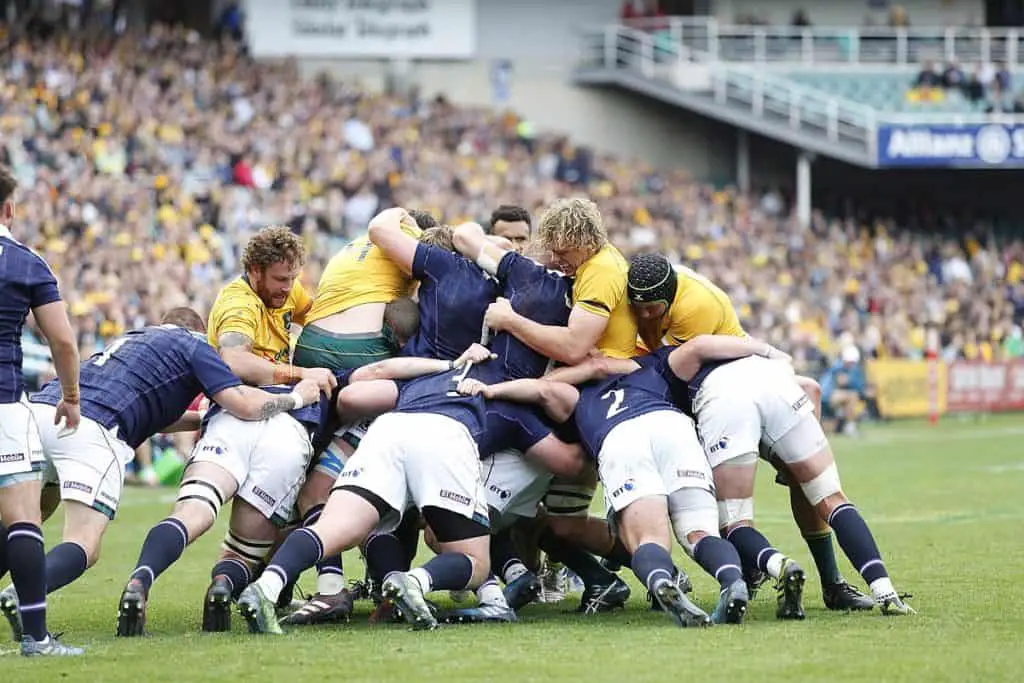Rugby players are big people, it is one thing to watch them on the TV screen, but to stand next to some of the biggest rugby players will make you think they are a different breed of humans. There is a clear difference between how big rugby players are now, compared to how big (or rather small) they were in the past.
Rugby players are heavy and strong, some may even say fat, because these attributes are advantageous in a rugby match for overpowering the opposing team using brute force in scrums, rucks and mauls. However, not all positions in rugby favor size and strength, some positions require more speed and agility.
Rugby players have gotten ridiculously big over the years, especially since the sport turned professional in 1995 and players began hitting the weights full-time.
It is hard to believe that some of these giants can play almost eighty minutes of a game where players are required to sprint and tackle one another constantly.
Why Are Rugby Players So Big?
Saying that the sport of rugby is physical is an understatement. For eighty minutes, players on a field a hundred and thirty yards long try to get a ball to one side while the opposing team can perform brutal tackles on players holding the ball.
Unsurprisingly, rugby requires its players to be strong to gain a physical advantage over the team. Players purposefully put on weight and gain muscle mass to avoid being overwhelmed by the opposing team and try to break their line of defense.
Not only do players need to be heavy and robust due to rugby’s intense physicality, but players also need to have fantastic endurance. When they are not busy tackling someone to the ground or performing scrums, rugby players spend their time running all over the rugby field.
Being the bigger player on the field also means reducing your risk of injury. Unlike in American Football, where players wear padding and helmets, rugby players have close to no protection but still charge in to one another with great force.
It is usually the case that when a bigger player tackles a much smaller player, the smaller player needs some time to get back up, or it simply takes more people to tackle the bigger player.
The advantage of this is that it creates more space elsewhere for other players that are quicker, normally the backs, to run in to. This is why it is said that rugby is a game fo all shapes and sizes.
Forwards are expected to physically win the ball from their opponents through scrums, rucks, mauls and tackles require great power and strength and then allow the ball to be passed to the backs whose job it is to run into the spaces that the forwards have created.
You might want to read: What is the average size of a professional rugby player?
Some Rugby Players Need To Be Bigger Than Others
If you pay attention while watching a rugby match, you will notice that some players on a team are much bigger or ‘fatter’ than their teammates. There is a good reason for this. Though some people unfamiliar with the game think that rugby is all about brute force, they are wrong.
Like in any other team sport, players in rugby are assigned different positions requiring different skills and other attributes. The positions in rugby where players on teams are the heaviest are the forwards.
Rugby teams count on these players to successfully perform tackles, scrums, and mauls at high force that are crucial for winning the match.
However, it is not just about being heavy and strong in rugby, as all players on the field need all-around fitness that balances strength, cardio, and agility. Even the heaviest rugby players on the team who look like powerlifters have to have fantastic cardio fitness, skill, and speed.
The Advantages Of Being Bigger In Rugby
Being bigger in rugby also means being stronger. Big and strong players can provide support to their teammates in several ways.
For example, if a player on the team gets tackled to the ground, the bigger players can form a ‘ruck’ around their tackled teammate more easily being more difficult to push backwards.
The ruck acts as a barrier, which protects the tackled player holding the ball, allowing them to retain possession. The strong and heavy forwards from the opposing team try to penetrate the ruck in an attempt to steal the ball.
There are many other instances in a rugby game where weight and strength come into play to determine which team gains the upper hand. During plays where a ‘pack’ of players, in a scrum or maul, tries to wrestle and/or push through the opposing team’s defenses, the heavier and stronger players usually win.
The South African international team is known for its strong and heavy players. The forwards on that team, including the shocking stats of giant Eben Etzebeth, who is 6’8’’ and weighs 258 pounds, are known for ‘bullying’ other teams with their brute strength. Their front row forwards were at one point known as ‘The Bomb Squad’ such was their devastating power.
All that said, why not read: Why you don’t have to be tall to play rugby

How Do Rugby Players Get So Big?
Rugby players must maintain appropriate diets and physical exercise routines to main their fitness level. The physically demanding sport requires its players to keep high muscle mass and low-fat levels.
Heavier players follow different training and nutritional regimes than smaller players because they play different roles on the rugby field.
Certain factors come into play when considering a player’s muscle mass and weight are; training, diet, sleep quality, total body weight, body composition, and appetite.
Rugby Players Do Strength And Conditioning Workouts
Rugby players follow specific training plans to build muscle and strength. These athletes do a lot of resistance training to develop their strength and muscle mass.
Rugby trainers develop strength & conditioning programs that include a lot of resistance training which mirrors the same kind of movements players perform during a rugby match.
A rugby player’s training for muscle building and strength usually includes the following:
- Deadlifts
- Bench Presses
- Squats (with weights)
- Sled sprinting
- Cleans
- Romanian deadlifts
- Lunges (with weights)
- Step ups (with weights)
Rugby Players Eat A Lot Of Food
The exertion of rugby players during training and matches requires them to eat a lot of food to keep their energy levels stable. Rugby players will train more than once a day, so eating a lot of the right foods is vital to maintain their weight and strength and maximizing recovery.
Players must consider certain aspects of their diet when trying to put on muscle mass.
Positive calorie intake. A positive calorie intake results in a positive energy balance which is essential for muscle growth. Players aim to have a surplus of at least three hundred calories every day and sometimes much more.
High protein intake. Consumption of enough protein is critical for muscle growth and retention. A positive net balance results in more protein being formed than proteins breaking down. Players eat around two grams per kilogram body weight of protein every day.
Supplements. Rugby players take supplements to promote muscle growth and prevent nutrient deficiencies. These supplements include protein, vitamin D3, omega-3 fatty acids, and creatine.
Do You Have To Be Big To Play Rugby?
You do not necessarily need to be big to play rugby, although it is beneficial to have a good amount of muscle on you, no matter your position.
Regarding height, some of the best players in the world are shorter than you might expect. Two current rugby stars, Cheslin Kolbe and Antoine Dupont, measure 5’7’’ and 5’9’’, respectively, yet they are considered two of the best players in the world at the moment. Their positions on the rugby field do not require them to be tall, heavy, and strong.
Thus, people wanting to play rugby but do not have the physical attributes to be a forward can always train to play for a position that requires less weight and brute strength.
Rugby players gain weight and muscle mass to increase their strength. Being stronger than the opposing team’s players enables players to overwhelm the other team using their physical tenacity.
You might also like: What positions do the biggest rugby players play?
Image credits
3 October 2014, 20:52:55, A maul, Clément Bucco-Lechat, CC BY-SA 3.0, via Wikimedia Commons
The 2017 mid-year rugby union international, 17 June 2017, Australia vs Scotland at Allianz Stadium, Sydney www.davidmolloyphotography.com from Sydney, Australia, CC BY 2.0, via Wikimedia Commons
